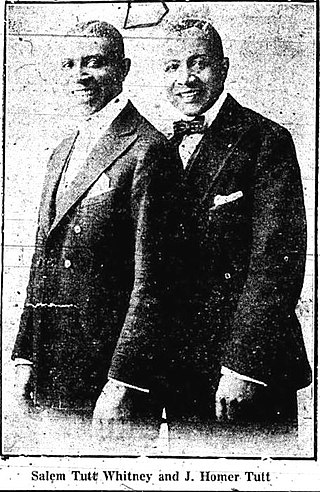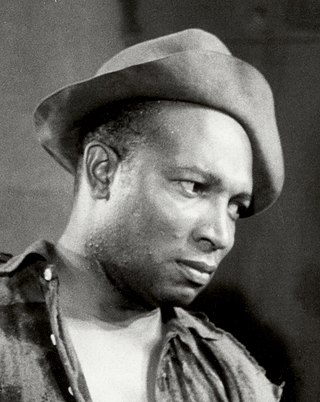Related Research Articles
Theatre Owners Booking Association, or T.O.B.A., was the vaudeville circuit for African American performers in the 1920s. The theaters mostly had white owners, though there were exceptions, including the recently restored Morton Theater in Athens, Georgia, originally operated by "Pinky" Monroe Morton, and Douglass Theatre in Macon, Georgia owned and operated by Charles Henry Douglass. Theater owners booked jazz and blues musicians and singers, comedians, and other performers, including the classically trained, such as operatic soprano Sissieretta Jones, known as "The Black Patti", for black audiences.

African-American musical theater includes late 19th and early 20th century musical theater productions by African Americans in New York City and Chicago. Actors from troupes such as the Lafayette Players also crossed over into film. The Pekin Theatre in Chicago was a popular and influential venue.

Flournoy Eakin Miller, sometimes credited as F. E. Miller, was an American entertainer, actor, lyricist, producer and playwright. Between about 1905 and 1932 he formed a popular comic duo, Miller and Lyles, with Aubrey Lyles. Described as "an innovator who advanced black comedy and entertainment significantly," and as "one of the seminal figures in the development of African American musical theater on Broadway", he wrote many successful vaudeville and Broadway shows, including the influential Shuffle Along (1921), as well as working on several all-black movies between the 1930s and 1950s.

Aubrey Lee Lyles, sometimes credited as A. L. Lyles, was an American vaudeville performer, playwright, songwriter, and lyricist. He appeared with Flournoy E. Miller as Miller and Lyles as a popular African-American comedy duo from 1905 until shortly before his death. in 1929 they appeared on film as grocers in the Vitaphone Varieties short comedy film They Know Their Groceries.

Salem Tutt Whitney and J. Homer Tutt, known collectively as the Tutt Brothers, were American vaudeville producers, writers, and performers of the late 19th and early 20th century. They were also known as Whitney & Tutt, Tutt & Whitney and the Whitney Brothers. They were prominent in black vaudeville and created over forty revues for black audiences.
A number of theatre companies are associated with the Harlem Renaissance.

Irvin Colloden Miller was an American actor, playwright, and vaudeville show writer and producer. He was responsible for successful theater shows including Broadway Rastus (1921), Liza (1922), Dinah (1923), which introduced the wildly popular black bottom dance, and Desires of 1927 starring Adelaide Hall. For thirty years he directed the popular review, Brown Skin Models, influenced by the Ziegfeld Follies but exclusively using black performers. "In the 1920s and 1930s, he was arguably the most well-established and successful producer of black musical comedy."
Hattie McIntosh was a vaudeville performer who toured with successful shows and her husband, fellow performer Tom McIntosh (comedian).
Rang Tang is a musical that premiered July 12, 1927, on Broadway at the Royale Theater and ran for 119 performances, including a 14-week overrun, during which, the production moved September 12, 1927, to the Majestic – finishing October 24, 1927. It was acclaimed as one of the most successful black musical revues of the latter 1920s, and owed much to a star-laden cast headlined by Flournoy Miller and Aubrey Lyles. The book — in 2 acts and 12 scenes — is by Kaj Gynt; the lyrics are by Joseph H. Trent; the music is composed by Ford Dabney, who tailored some of the songs for Mae Barnes and Evelyn Preer; the score and post-production music was published by Leo Feist; all copyrighted in 1927 and copyrights renewed in 1954.

Emmett Anthony was an American vaudeville comedian who appeared on stage in various revues and shows. In December 1915 he arrived in New Orleans on the S.S. Brunswick to perform at the Iroquis Theater. He was also in the film Son of Satan and was part of Blackville Corporation's 1915 touring revival, The Mayor of Jimtown touring show in 1923, and Harlem Darlings revue in 1929. He featured as a regular at the Crescent Theatre in 1913. He was in Liza in 1923. He received a favorable assessment for his part in Put and Take.

J. Augustus Smith, also known as Gus Smith, was an American actor, playwright, and screenwriter. In 1936 he was one of three theatre artists who succeeded John Houseman in leading the Negro Theatre Unit of the Federal Theatre Project in New York City.
Charlotte Grady Roxborough was a singer, dancer, and comedian who performed in theatrical productions and vaudeville as well as films. She was born to Wesley, a white father, and Susan (Kelly) Grady. She performed at the Pekin Theatre in Chicago where she was a star member of its stock company. She starred in William Foster's The Pullman Porter, in 1912, the first black motion picture production.
Jerry Mills was a performer at the Pekin Theatre in Chicago. and in films.
Blondie Robinson, also sometimes written as Blondi Robinson, was an African American renowned vaudeville comedic act performer.
Harrison Stewart was a comedic actor and lyricist in the United States. He performed at the Pekin Theater in Chicago where he became a star and received top billing.
J. Edward Green was an actor, playwright and production manager in the United States. He authored, directed, and acted in shows at the Pekin Theatre in Chicago. He staged works including musical comedies Captain Rufus, In Zululand, The Man from 'Bam, Mayor of Dixie, Two African Princes, Honolulu, Queen of the Jungles, Twenty Minutes from State Street, My Nephew's Wife, My Friend from Georgia, A Trip to Coontown, The Count of No Account, In Eululand, The Grafters and Doctor Dope. Doctor Dope was by Stanley Woods (playwright).
Willis J. Accooe was an American performing musician and composer, mainly of musicals. He was "an important songwriter during the birth of the black musical" according to the Library of Congress website.
Joe Byrd was a vaudeville comedian. He was from Jacksonville, Florida.
George Washington Bullion was a popular and long running three act musical comedy by the Tutt Brothers, Salem Tutt Whitney and J. Homer Tutt that debuted in 1910. Trevor L. Corwell, a white English impresario helped book the show. The storyline featured a black tobacco plantation owner aspiring to join high society. The Tutt brothers’ shows George Washington Bullion Abroad and How Newtown Prepared followed up on the characters in 1915 and 1916. Both shows had the characters of Washington and fellow veterans leaving to fight in foreign wars.
Howard Kelly was a vaudeville and film actor in the United States. He was part of the Pekin Theatre’s stock company. He started in some of William D. Foster’s Foster Photoplay Company films including The Railroad Porter and The Barber.
References
- ↑ Blacks in Blackface page 1381
- ↑ Hill, Errol; Hatch, James V. (July 17, 2003). A History of African American Theatre. Cambridge University Press. ISBN 9780521624435 – via Google Books.
- ↑ Sampson, Henry T. (October 30, 2013). Blacks in Blackface: A Sourcebook on Early Black Musical Shows. Scarecrow Press. ISBN 9780810883512 – via Google Books.
- ↑ "archives.nypl.org -- Flournoy Miller collection". archives.nypl.org.
- ↑ Blacks in Blackface page 56
- ↑ Peterson, Bernard L. Jr. (October 25, 1993). A Century of Musicals in Black and White: An Encyclopedia of Musical Stage Works By, About, or Involving African Americans: An Encyclopedia of Musical Stage Works By, About, or Involving African Americans. ABC-CLIO. ISBN 9780313064548 – via Google Books.
- ↑ Carson, Lionel (April 14, 1909). "The Stage Year Book". Stage Offices – via Google Books.
- ↑ Peterson, Bernard L.; Peterson, Bernard J. (April 14, 1990). Early Black American Playwrights and Dramatic Writers: A Biographical Directory and Catalog of Plays, Films, and Broadcasting Scripts. Greenwood Publishing Group. ISBN 9780313266218 – via Google Books.